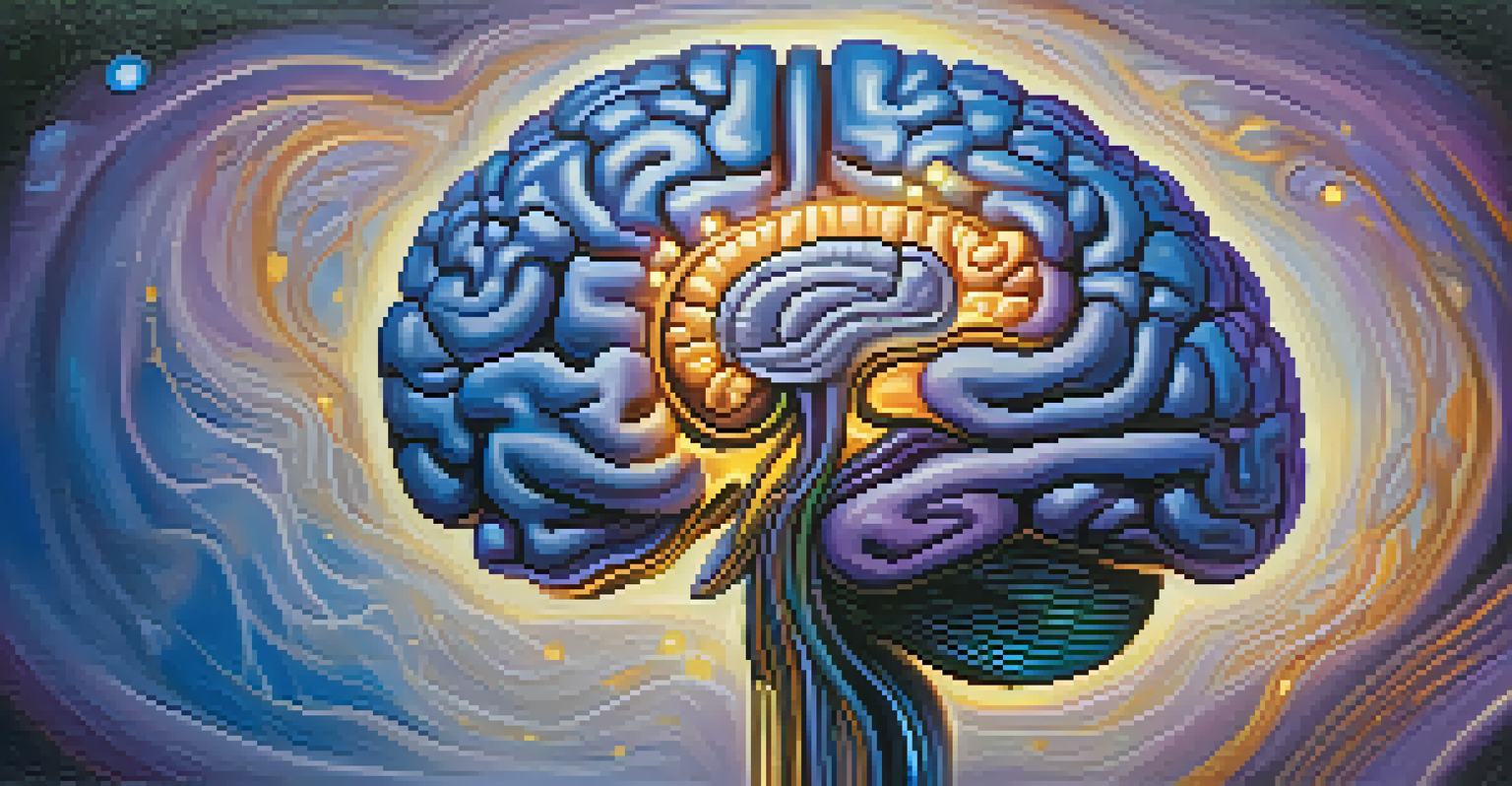Neuroscience of Dreams: Insights from Entheogen Use

Understanding Dreams: A Window into the Subconscious
Dreams have fascinated humans for centuries, acting as a bridge between our conscious and subconscious minds. They reflect our thoughts, emotions, and experiences, often revealing insights we may not access while awake. Neuroscience suggests that during REM sleep, our brain is highly active, almost mimicking the state of being awake, which is when the most vivid dreams occur.
Dreams are the touchstones of our character.
In this heightened state of consciousness, the brain processes memories and emotions, weaving them into complex narratives. This phenomenon can sometimes lead to what feels like profound revelations or problem-solving insights. Essentially, dreams can serve as a mental playground where our mind explores different scenarios and emotions without the constraints of reality.
Understanding the mechanics of dreaming can help us appreciate its significance in our lives. Whether it's a fleeting thought or a detailed storyline, each dream has the potential to provide clues about our mental state and emotional well-being.
What Are Entheogens? A Brief Overview
Entheogens are substances that can induce altered states of consciousness, often used in spiritual or ceremonial contexts. These include naturally occurring compounds like psilocybin (found in magic mushrooms) and ayahuasca, which have been used for centuries by various cultures for healing and introspection. The term 'entheogen' comes from the Greek words meaning 'generating the divine within.'

When consumed, entheogens can lead to experiences that profoundly alter perception, emotions, and consciousness. Users often report feelings of interconnectedness, heightened awareness, and sometimes, vivid dream-like experiences. This connection to the dream state raises questions about the overlap between dreaming and the effects of these substances.
Dreams Reflect Our Subconscious
Dreams serve as a bridge between our conscious and subconscious minds, revealing insights about our thoughts and emotions.
Incorporating entheogens into discussions about dreaming can illuminate how both experiences tap into the deeper workings of the mind. By examining their effects, we can better understand the potential for these substances to enhance or alter our dream experiences.
Neuroscience Behind Dreams: What Happens in Our Brains?
The neuroscience of dreaming involves several brain regions, primarily the prefrontal cortex, amygdala, and hippocampus. The prefrontal cortex, responsible for rational thought, tends to be less active during dreams, allowing for more abstract and emotional experiences. Meanwhile, the amygdala, which processes emotions, is quite active, often leading to heightened feelings during dreams.
The use of entheogens in spiritual practices can lead to profound insights and experiences of interconnectedness.
The hippocampus plays a critical role in memory formation and retrieval, which explains why our dreams often incorporate familiar people and events. When we dream, our brain essentially sifts through our day-to-day experiences, combining them with our emotions to create a narrative that can be both bizarre and meaningful. This intricate process showcases how our brain works tirelessly, even when we think we are resting.
Understanding these neural activities enriches our appreciation of dreams. It also opens doors for exploring how entheogens might influence these brain functions and, by extension, our dream experiences.
Entheogens and Dream Enhancement: A Unique Connection
Research suggests that certain entheogens can enhance dream vividness and recall. For instance, users of substances like psilocybin often report more intense and memorable dreams. This phenomenon may be attributed to the way these substances alter brain chemistry, particularly the serotonin system, which plays a significant role in mood regulation and perception.
Moreover, some entheogens can induce a state of consciousness similar to REM sleep, where the most vivid dreams occur. This similarity raises intriguing questions about whether these substances can provide a shortcut to dream-like states, allowing users to explore their subconscious in a more profound way. It's as if entheogens offer a key to unlock a hidden chamber within our minds.
Entheogens Enhance Dream Experiences
Certain entheogens can amplify dream vividness and recall, potentially allowing for deeper exploration of the subconscious.
The potential for entheogens to enhance our dream life could lead to greater self-awareness and emotional healing. As we delve deeper into this connection, we may uncover new approaches to therapy and personal growth through dream exploration.
The Role of Neurotransmitters in Dreams and Entheogens
Neurotransmitters are chemical messengers that play essential roles in regulating mood, sleep, and overall brain function. Two key players in the realm of dreams are serotonin and dopamine. Serotonin is known to influence mood and emotional regulation, while dopamine is associated with pleasure and reward, both of which can affect how we dream and remember our dreams.
Entheogens can significantly impact these neurotransmitter systems, often leading to increased serotonin levels. This boost can result in heightened emotional experiences and more vivid dream recall, offering users a unique glimpse into their subconscious. It's fascinating to consider how altering these chemical pathways can lead to richer dream experiences.
By understanding the role of neurotransmitters in both dreaming and entheogen use, we can begin to appreciate the complex interplay between our biology and consciousness. This knowledge not only enhances our understanding of dreams but also the therapeutic potential of entheogens.
Cultural Perspectives on Dreams and Entheogen Use
Throughout history, various cultures have viewed dreams as portals to the spiritual realm, often seeking guidance or wisdom through them. Indigenous cultures, in particular, have utilized entheogens in conjunction with dream practices, viewing them as interconnected pathways to understanding the self and the universe. This perspective sheds light on the spiritual significance of dreaming and the role entheogens can play in enhancing that connection.
For example, many Indigenous communities use ayahuasca in ceremonial settings to facilitate deep introspection and dream exploration. Participants often report experiencing vivid, transformative visions that provide insights into their lives and spiritual journeys. These experiences illustrate how entheogens can serve as tools for dream enhancement and personal growth.
Cultural Views on Dreams Matter
Various cultures see dreams as spiritual portals, often using entheogens to enhance dream practices and personal growth.
By examining these cultural practices, we can gain a deeper appreciation for the holistic view of dreams and entheogen use. This understanding may inspire modern therapeutic approaches that integrate these ancient traditions into contemporary mental health practices.
Future Directions: Research and Implications
As interest in the therapeutic benefits of entheogens continues to grow, so does the need for rigorous scientific research. Studies exploring the relationship between dream enhancement and entheogen use could open new avenues for understanding mental health and consciousness. This research could lead to innovative therapies that leverage the power of dreams and altered states for healing.
Moreover, understanding the nuances of how entheogens affect dreaming can contribute to broader discussions about consciousness itself. Questions surrounding the nature of reality, perception, and the subconscious are at the forefront of scientific inquiry, and dreams play a crucial role in these explorations. As we uncover more about the brain's workings, we may find new applications for entheogens in psychological and spiritual practices.

Ultimately, the intersection of neuroscience, dreams, and entheogen use offers a rich tapestry of insights waiting to be explored. By continuing to investigate these connections, we can further unravel the mysteries of the mind and the transformative potential of our dream lives.